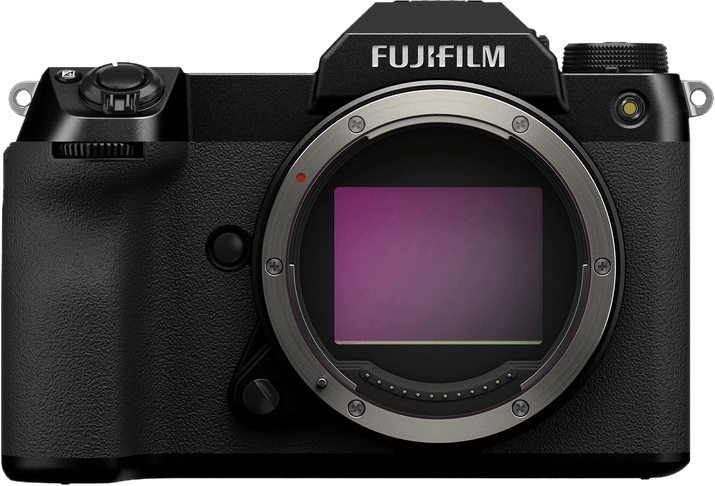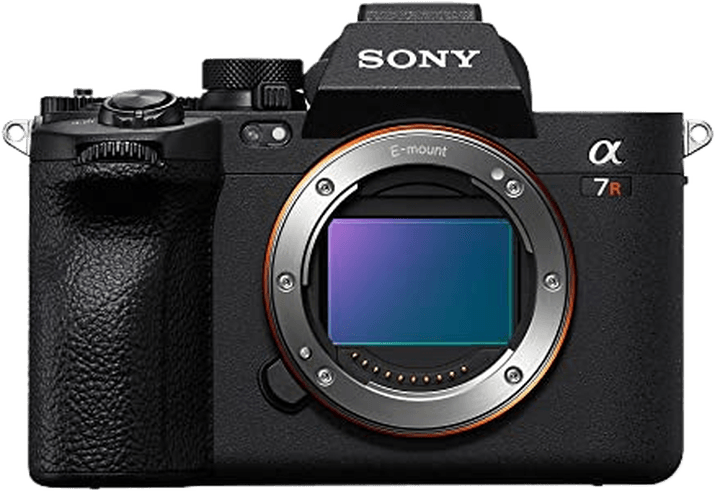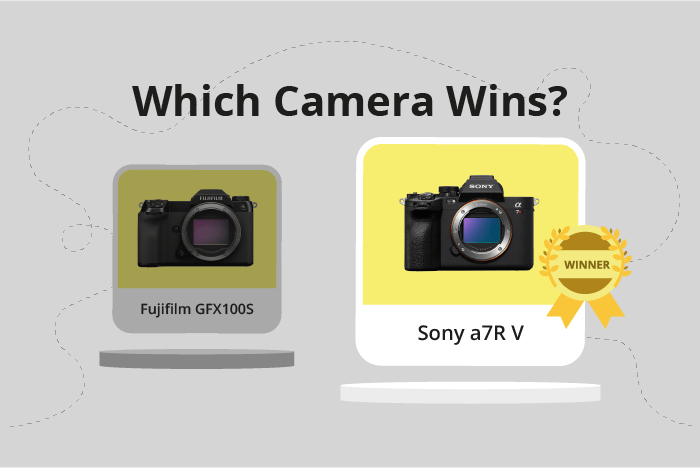Fujifilm GFX100S vs Sony a7R V Comparison
Fujifilm GFX100S

Sony a7R V

The Sony a7R V outperforms the Fujifilm GFX100S with a score of 85/100 compared to 80/100. Both cameras are mirrorless and were released within a year of each other, in 2021 and 2022 respectively. They share similarities in their design and functionality.
The Fujifilm GFX100S has its strengths, such as a larger size (150 x 104 x 87mm) and heavier weight (900g) which may provide better stability for some users. However, its launch price is significantly higher at $5999, compared to the Sony a7R V’s $3999.
On the other hand, the Sony a7R V is more compact (131 x 97 x 82mm) and lighter (723g), making it easier to carry and handle. Its lower price point also makes it a more attractive option for those on a budget.
Taking these factors into account, the Sony a7R V is the superior choice for its balance of performance, size, and affordability. The Fujifilm GFX100S, while having its advantages, falls short in comparison.
Fujifilm GFX100S vs Sony a7R V Overview and Optics
In comparing the optics of the Fujifilm GFX100S and the Sony a7R V, the Sony a7R V emerges as the winner with a score of 85/100, compared to the Fujifilm GFX100S’s 78/100. Both cameras share several common specifications, such as CMOS sensor type, image stabilization, and lens mounts specifically designed for their respective brands.
The Sony a7R V’s superiority in optics can be attributed to its faster shooting speed of 10 frames per second, compared to the GFX100S’s 5 frames per second. This allows for capturing fast-moving subjects and better performance in action photography. Moreover, the a7R V has a DXOMARK score of 94 for its sensor, while the GFX100S does not have a DXOMARK score. The Sony a7R V also features a full-frame sensor size and a 3:2 aspect ratio, making it ideal for a variety of applications, including landscape and portrait photography.
On the other hand, the Fujifilm GFX100S has an impressive 102-megapixel resolution, significantly higher than the Sony a7R V’s 61 megapixels. This results in greater detail and image quality, particularly for large prints and high-resolution applications. Additionally, the GFX100S has a medium-format sensor size and a 4:3 aspect ratio, catering to those who prefer a larger sensor and a more square image format.
Taking these points into consideration, the Sony a7R V offers a higher overall score in optics due to its faster shooting speed, full-frame sensor size, and recognized sensor quality. However, the Fujifilm GFX100S excels in megapixel count and a medium-format sensor, making it an attractive option for photographers who prioritize detail and image quality. Ultimately, the choice between these two cameras will depend on the specific needs and preferences of the photographer.
Fujifilm GFX100S vs Sony a7R V Video Performance
The Sony a7R V emerges as the winner in the video capabilities comparison with a score of 100/100, while the Fujifilm GFX100S scores 83/100. Both cameras have time-lapse functionality built-in, which is a common feature.
The Sony a7R V outperforms the Fujifilm GFX100S in several aspects. First, it has a higher video resolution of 8K, compared to the 4K resolution of the GFX100S. This means that the a7R V can capture more detail and produce higher quality video footage. Additionally, the Sony a7R V boasts a maximum video frame rate of 120fps, which is double the 60fps offered by the GFX100S. This higher frame rate allows for smoother slow-motion footage and better overall video performance.
However, the Fujifilm GFX100S also has its advantages. Although its video capabilities are not as impressive as the Sony a7R V, the GFX100S still provides good quality 4K footage. For many users, this resolution may be sufficient for their needs. Additionally, the 60fps frame rate is still suitable for general video recording and some slow-motion effects.
Taking these factors into account, the Sony a7R V is the superior choice for those who prioritize video performance, with its 8K resolution and 120fps frame rate. On the other hand, the Fujifilm GFX100S remains a solid option for users who may not require the highest video capabilities, but still desire good quality 4K footage. Both cameras offer time-lapse functionality, making them versatile tools for photographers and videographers alike.
Fujifilm GFX100S vs Sony a7R V Features and Benefits
The Fujifilm GFX100S and the Sony a7R V both have a feature score of 87 out of 100, making them equal in terms of their overall capabilities. They share several specifications, such as a 3.2-inch screen size, touchscreen functionality, flip screen, absence of GPS, and the inclusion of WiFi and Bluetooth connectivity.
The Fujifilm GFX100S has a slight advantage in screen resolution with 2,360,000 dots compared to the Sony a7R V’s 2,100,000 dots. This higher resolution offers a clearer and more detailed display for the user, which can be helpful in various shooting situations.
On the other hand, the Sony a7R V does not have any specific advantages over the Fujifilm GFX100S in terms of features, as both cameras share similar specifications. However, it is essential to consider that the overall performance and quality of a camera are not solely determined by its feature score. Other factors, such as sensor size, image quality, autofocus performance, and ergonomics, can significantly impact the user experience and the final output.
Considering the shared specifications and the slight edge of the Fujifilm GFX100S in screen resolution, both cameras are highly capable and can meet the requirements of various photography styles and situations. Ultimately, the choice between these two cameras should depend on the user’s personal preferences and specific needs, as well as any additional features and performance aspects not covered in this comparison.
Fujifilm GFX100S vs Sony a7R V Storage and Battery
The Fujifilm GFX100S and Sony a7R V both score 73/100 in storage and battery, displaying their similarities in this aspect. Each camera has two memory card slots and accepts SD, SDHC, and SDXC cards. They also support USB charging, enhancing convenience during usage.
However, the Sony a7R V edges ahead with a slightly longer battery life of 530 shots, compared to the Fujifilm GFX100S’s 480 shots. The Sony a7R V also accepts CFexpress Type A cards, offering users more storage options.
On the other hand, the Fujifilm GFX100S uses the NP-W235 battery type, which may be more accessible for some users, depending on their existing gear.
Both cameras perform well in storage and battery, with the Sony a7R V providing a marginally longer battery life and additional storage compatibility. The Fujifilm GFX100S, though, may offer a more accessible battery type for certain users.
Fujifilm GFX100S vs Sony a7R V – Our Verdict
Are you still undecided about which camera is right for you? Have a look at these popular comparisons that feature the Fujifilm GFX100S or the Sony a7R V:

